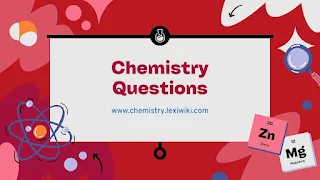Questions on Ionization Energy
Multiple-Choice Questions: Ionization Energy
🔹 Basic Concepts
1. What is ionization energy?
A) Energy released when an atom gains an electron
B) Energy required to remove an electron from a neutral atom in the gaseous state
C) Energy required to form a bond
D) Energy needed to split a nucleus
E) Energy absorbed during fusion
2. Which element has the highest first ionization energy?
A) Hydrogen
B) Helium
C) Fluorine
D) Neon
E) Oxygen
3. Why does ionization energy generally increase across a period?
A) More electron shielding
B) Decreasing nuclear charge
C) Increasing nuclear charge with constant shielding
D) More neutrons are added
E) Decrease in mass
4. What is the trend of ionization energy down a group?
A) Increases
B) Decreases
C) Remains constant
D) Increases, then decreases
E) Is unpredictable
5. Which of the following has the lowest first ionization energy?
A) Lithium
B) Sodium
C) Potassium
D) Rubidium
E) Cesium
🔹 Comparative Questions
6. Which of these elements has the highest ionization energy in Period 3?
A) Sodium
B) Magnesium
C) Aluminum
D) Sulfur
E) Argon
7. Which element would have a higher ionization energy: Be or B?
A) Be, because it has a full s-subshell
B) B, because it has more protons
C) Be, because it is a metalloid
D) B, because it has more electrons
E) Both are equal
8. Which noble gas has the highest ionization energy?
A) He
B) Ne
C) Ar
D) Kr
E) Xe
9. Which of the following has a higher first ionization energy than calcium?
A) Potassium
B) Strontium
C) Magnesium
D) Barium
E) Rubidium
10. What best explains the drop in ionization energy from nitrogen to oxygen?
A) Increased nuclear charge
B) Decrease in atomic size
C) Half-filled p orbital stability in nitrogen
D) Increase in shielding
E) Electron loss is easier in nitrogen
🔹 Advanced Questions
11. Which group has the lowest ionization energies?
A) Halogens
B) Noble gases
C) Alkali metals
D) Transition metals
E) Metalloids
12. Which factor does not directly affect ionization energy?
A) Atomic radius
B) Nuclear charge
C) Number of neutrons
D) Electron shielding
E) Electron configuration
13. Why does helium have such a high ionization energy?
A) It has one valence electron
B) Small atomic radius and strong nuclear pull
C) Large atomic radius
D) High neutron number
E) It is radioactive
14. What happens to ionization energy as atomic radius increases?
A) Increases
B) Decreases
C) Remains the same
D) First increases, then decreases
E) Fluctuates randomly
15. Which transition shows the greatest increase in ionization energy?
A) First to second ionization of Na
B) First to second ionization of Mg
C) First to second ionization of Al
D) First to second ionization of Cl
E) First to second ionization of Si
🔹 Ionization Energy Series
16. Which of the following has the highest second ionization energy?
A) Na
B) Mg
C) Al
D) Si
E) P
17. Which element is most likely to lose an electron easily?
A) Na
B) Mg
C) Cl
D) Ne
E) Ar
18. Which would show a dramatic increase in ionization energy after removing one electron?
A) Na
B) Mg
C) Al
D) Cl
E) K
19. Ionization energy is a measure of:
A) Nuclear attraction to protons
B) Electron-electron repulsion
C) The ease of forming an anion
D) The difficulty in removing an electron
E) Energy required to gain electrons
20. Which electron is being removed in the second ionization energy of sodium (Na)?
A) 1s
B) 2s
C) 3s
D) 2p
E) 3p
- Questions on Transition Metals (d-block elements)
- Questions on Lanthanides and Actinides
- Questions on Atomic Radius
Answers with Explanations
1. B – Ionization energy is the energy required to remove an electron from a gaseous atom.
2. B – Helium has the highest first ionization energy due to its small size and full shell.
3. C – As you go across a period, nuclear charge increases, pulling electrons tighter.
4. B – Down a group, electrons are farther from the nucleus and more shielded.
5. E – Cesium has the lowest ionization energy as it's farthest down Group 1.
6. E – Argon has a full octet and small radius, leading to the highest ionization energy in Period 3.
7. A – Beryllium has a full 2s subshell, making it more stable than boron.
8. A – Helium is the smallest noble gas and its electrons are held very tightly.
9. C – Magnesium is higher up the group and has a smaller atomic radius than calcium.
10. C – Nitrogen has a stable half-filled p subshell, making its electrons harder to remove.
11. C – Alkali metals lose electrons easily due to their large atomic radii.
12. C – Number of neutrons does not directly impact ionization energy.
13. B – Helium's small size and strong nuclear force mean it holds its electrons very tightly.
14. B – As atomic radius increases, outer electrons are less attracted to the nucleus.
15. A – Na's second electron must come from a full inner shell, requiring much more energy.
16. A – Na loses its one 3s electron easily; the second electron comes from a full inner shell.
17. A – Sodium loses its single valence electron easily due to low ionization energy.
18. A – After losing one electron, Na becomes a stable noble gas configuration; removing another electron requires much more energy.
19. D – Ionization energy is the energy required to remove an electron.
20. B – After the 3s electron is removed, the next is a 2s electron, which is much closer to the nucleus.
Dive into the groundbreaking science of neurotransmitters—your brain’s invisible architects—in Chemical Harmony: How Neurotransmitters Shape Our Lives (2025). This meticulously researched book reveals how serotonin, dopamine, GABA, and other brain chemicals silently orchestrate every aspect of your existence, from decision-making and relationships to mental health and emotional resilience.Click here to buy
Share Online!

